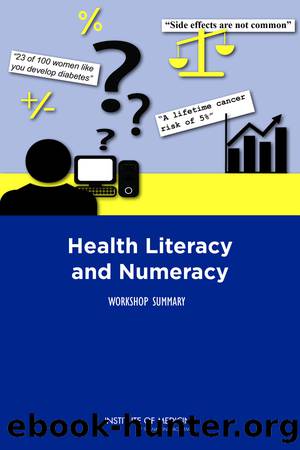Health Literacy and Numeracy: Workshop Summary by Melissa G. French

Author:Melissa G. French
Language: eng
Format: epub
Tags: ebook, book
Publisher: The National Academies Press
Published: 2014-07-24T00:00:00+00:00
WHY ARE YOU GIVING ME THIS NUMBER?: COMMUNICATING QUANTITATIVE INFORMATION FOR DECISION MAKING
Brian J. Zikmund-Fisher, Ph.D.
Department of Health Behavior and Health Education,
University of Michigan
Zikmund-Fisher said his presentation was not a review of the evidence on numeracy, but an argument that he hoped would be provocative. He began with the example of a fictional person called âRobertâ (Zikmund-Fisher, 2013a). Robert is a stereotypical middle-age man living in the United States. He is not as healthy as he should be or wishes to be because he has hypertension, is overweight, and does not get enough exercise. Robert decides to use an online risk calculator to find out whether he is at risk for cardiovascular disease. The risk calculator asks Robert his blood pressure, his weight and height, his cholesterol, and a few other pieces of information before providing the result. Robert learns that his 10-year risk of cardiovascular disease is 14.52 percent. But Robert is confused; he still does not know whether he is at high risk or not.
The number provided to Robertâ14.52 percentâmay be the best estimate of his risk of disease that modern medicine could give him, Zikmund-Fisher said. Yet that number does not meet Robertâs need for information. Robertâs risk is not being effectively communicated to him through that number. Zikmund-Fisher said there are several problems with the way that his risk of cardiovascular disease was communicated to Robert. First, there is the level of precision. Although it is common for risk calculators to give numeric risk estimates to two decimal points, it is not necessary or beneficial. Research has shown that an integer is considered more believable as well as easier to remember than a more precise representation of risk (Witteman et al., 2011).
More important, Zikmund-Fisher added, is the fact that Robert did not get the information that he needed from the number. Robert needed to know whether he was at high risk of developing cardiovascular disease or not. Merely giving him a number does not answer that question for him. Decision-making research uses the term âinformation evaluabilityâ (Hsee, 1996), which means that the meaning of a number depends on its context and whether the number can be evaluated by itself or requires reference standards to convey meaning.
For example, Zikmund-Fisher said, if workshop participants were shown a number that corresponds to the level of dioxin in blood, many would not know how to evaluate that data (i.e., to know whether it represents a high or low concentration or even whether being high or low is good or bad). The sense of confusion that workshop participants likely felt when presented with information about dioxin is the same feeling that many patients have when they are given any type of number in a health or medical situation without the contextual knowledge to explain whether the number is good or bad. Another example might be a person with type 2 diabetes who is working to improve glycemic control. If this person starts with a hemoglobin A1c measurement of 9.3 percent and after some time lowers that number to 8.
Download
This site does not store any files on its server. We only index and link to content provided by other sites. Please contact the content providers to delete copyright contents if any and email us, we'll remove relevant links or contents immediately.
Parents as Care Managers by Gillian Bridge(697)
The Tapestry of Memory: Unraveling the Threads of the Mind by Bittner Karis & Chianese Gabriella & Priede PhD David L(540)
So Young, So Sad, So Listen: A Parents' Guide to Depression in Children and Young People by Philip Graham Nick Midgley(531)
Lucid Dying by Sam Parnia(472)
Vital Signs by Izzy Lomax-Sawyers(443)
Prepare the TCM License exam in a month Vol. 3: Acupuncture theory - channels, points, techniques and treatments(California, NCCAOM, Canadian exam) by Woosen Ur(391)
Oxford Textbook of Global Public Health by Roger Detels;Quarraisha Abdool Karim;Fran Baum;Liming Li;Alastair H Leyland;(358)
IVF Got This by Colette Centeno Fox(343)
The Censorship of Second Opinions: How the politics of "misinformation" captured healthcare during the Covid-19 pandemic by Ariel Herron(342)
Wilderness and Survival Medicine by Ellis Chris Breen & Dr Craig(280)
Introduction to Social Work Practice : A Practical Workbook by Herschel Knapp(279)
Eating and Growth Disorders in Infants and Children by Joseph L. Woolston(274)
How Data Happened by Unknown(258)
Boxed Set 1 Dermatology by Dr Miriam Kinai(256)
Selective Oxidation Catalysts Obtained by the Immobilization of Iron (III) Porphyrins on Layered Hydroxide Salts by Fernando Wypych Shirley Nakagaki & Guilherme Sippel Machado(246)
Zika Virus Biology, Transmission, and Pathways by Colin R. Martin(243)
Snake Oil: How Xi Jinping Shut Down the World by Michael P. Senger(237)
Positive health: 100+ research-based positive psychology and lifestyle medicine tools to enhance your wellbeing by Jolanta Burke Pádraic J. Dunne Trudy Meehan Ciaran A. O'Boyle Christian van Nieuwerburgh(233)
Global Health Governance and Commercialisation of Public Health in India by Anuj Kapilashrami Rama V. Baru(216)
